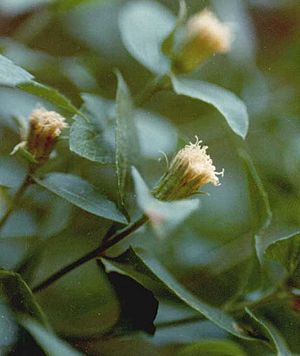Ageratina shastensis facts for kids
Ageratina shastensis is a special kind of plant known as a snakeroot. It's also called Mt. Shasta snakeroot or Shasta eupatorium. This plant is unique because it grows naturally only in one specific place: Shasta County, California. This makes it an "endemic" species, meaning it's found nowhere else in the world!
Quick facts for kids Ageratina shastensis |
|
|---|---|
 |
|
| Scientific classification | |
| Synonyms | |
|
Eupatorium shastensis Taylor & Stebbins |
Contents
About the Mt. Shasta Snakeroot
The Mt. Shasta snakeroot is a woody perennial plant. This means it has a stem that stays alive above ground for more than two years, like a small shrub. It grows to be about 30 to 60 centimeters (1 to 2 feet) tall.
What Does It Look Like?
This plant has simple, green leaves. Its flowers are small and white. They look fluffy and are about one centimeter wide. These flowers might seem plain, but they are quite charming.
Where Does It Grow?
Ageratina shastensis is an uncommon plant. It prefers to grow in the cracks of limestone cliffs. You can find it on Mount Shasta, which is a large volcano. Mount Shasta is part of the Cascade Range in northern California. This plant is very particular about its home!
The Meaning Behind the Name
The scientific name Ageratina comes from the Greek language. It means 'un-aging' or 'not growing old'. This name was given because the flowers of these plants keep their color for a long time.
Who Named It?
An ancient Greek doctor and botanist named Dioscorides first used this name. He used it for several different plants that shared this special quality. The second part of the name, shastensis, tells us where the plant is found. It refers to Mount Shasta and Shasta County, California.

